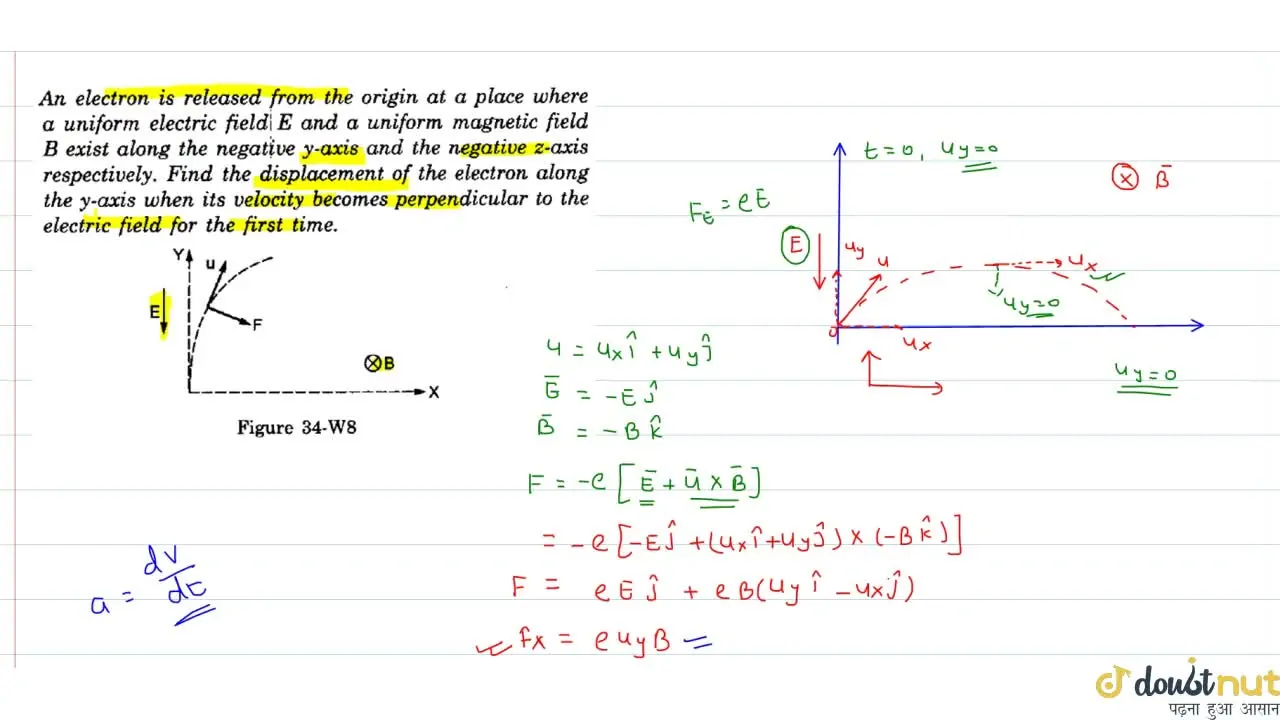An electron is released from the origin at a place where a uniform electric field E and a uniform magnetic field B exist along the negative y-axis and the nagative z-axis respectively. Find the displacement of the electron along the y-axis when its velocitybecomes perpendicular to the electric feld for the first time.

Let us take axes as shown in
According to the right handed system, the z-exis is
upward in the figure and hence the magnetic field
is shown downwards. At any time, the velocity of the
electron may be written as
The electric and magnetic fields may be written as
and ,
respectively . The force on the electron is
.
Thus, ,
and .
The components of the acceleration are
and .
we have,
=-omega^2u_yomega= (eB)/(m) (iii)u_y = A sin)omegat+delta) (iv)(du_y)(dt) = A omega cos(omegat+s). (v)At t = 0, u_y = 0(du_y)/(dt) = (F_y)/ (m)= (eE)/(m)delta = 0 and A = (eE)/(momega) = (E)/(B)u_y = (E)/(B) sin omegatsin omegat = 0omegat= pit=(pi)/(omega)=(pim)/(eB)u_y = (dy)/(dt)=(E)/(B) sin omegatint_0^y dy= (E)/(B) int_0^t sin omegat dty=(E)/(B omega) (1-cos omegat)t =(pi)/(omega),y=-(E)/(B omega)(1 - cos pi) = (2E)(B omega).(2E)/B omega) = (2Em)/(BeB) =(2Em)/(eB^2).
Related Playlists
- BOOK - HC VERMACHAPTER - MAGNETIC FIELDEXERCISE - Short Answer10videos
MAGNETIC FIELD
- BOOK - HC VERMACHAPTER - MAGNETIC FIELDEXERCISE - Objective 110videos
MAGNETIC FIELD
- BOOK - HC VERMACHAPTER - MAGNETIC FIELDEXERCISE - Exercises61videos
MAGNETIC FIELD
- BOOK - HC VERMACHAPTER - LIGHT WAVESEXERCISE - Exercises41videos
LIGHT WAVES
- BOOK - HC VERMACHAPTER - MAGNETIC FIELD DUE TO CURRENTEXERCISE - Exercises61videos
MAGNETIC FIELD DUE TO CURRENT
Similar Questions
A uniform electric field and a uniform magnetic field are acting along the same direction in a certain region. If an electron is projected in the same direction then the electron
View SolutionAn electron is released from rest in a region of uniform electric and magnetic fields acting parallel to each other. The electron will
View SolutionA uniform electric field and a uniform magnetic field are acting along the same direction in a certain region. If an electron is projected along the direction of the fields with a certain velocity then
View SolutionA charge particle enters into a region containing uniform electric field (E) and uniform magnetic field (B) along x-axis and y-axis respectively.If it passes the region undeviated the velocity of charge particle is given by
View SolutionDraw equipotential surfaces for a uniform electric field along z-axis.
View SolutionA charge particle enters into a region containing uniform electric field (E) and uniform magnetic field (B) along x- axis and y-axis respectively.If it passes the region undeviated the velocity of charge particle is given by
View SolutionA uniform electric field and a uniform magnetic field are acting along the same direction in a certain region. If an electron is projected in the region such that its velocity is pointed along the direction of fields, then the electron
View SolutionA uniform electric field and a uniform magnetic field are acting along the same direction in a certain region. If an electron is projected in the region such that its velocity is pointed along the direction of fields, then the electron
View SolutionA proton is placed in a uniform electric field directed along the positive x-axis . In which direction will it tend to move?
View SolutionAn electromagnetic wave is traveling in the positive x direction with its electric filed along the z axis and its magnetic field along the y axis . The fields are related by
View Solution


